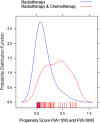Targeted maximum likelihood estimation for a binary treatment: A tutorial
- PMID: 29687470
- PMCID: PMC6032875
- DOI: 10.1002/sim.7628
Targeted maximum likelihood estimation for a binary treatment: A tutorial
Abstract
When estimating the average effect of a binary treatment (or exposure) on an outcome, methods that incorporate propensity scores, the G-formula, or targeted maximum likelihood estimation (TMLE) are preferred over naïve regression approaches, which are biased under misspecification of a parametric outcome model. In contrast propensity score methods require the correct specification of an exposure model. Double-robust methods only require correct specification of either the outcome or the exposure model. Targeted maximum likelihood estimation is a semiparametric double-robust method that improves the chances of correct model specification by allowing for flexible estimation using (nonparametric) machine-learning methods. It therefore requires weaker assumptions than its competitors. We provide a step-by-step guided implementation of TMLE and illustrate it in a realistic scenario based on cancer epidemiology where assumptions about correct model specification and positivity (ie, when a study participant had 0 probability of receiving the treatment) are nearly violated. This article provides a concise and reproducible educational introduction to TMLE for a binary outcome and exposure. The reader should gain sufficient understanding of TMLE from this introductory tutorial to be able to apply the method in practice. Extensive R-code is provided in easy-to-read boxes throughout the article for replicability. Stata users will find a testing implementation of TMLE and additional material in the Appendix S1 and at the following GitHub repository: https://github.com/migariane/SIM-TMLE-tutorial.
Keywords: causal inference; ensemble Learning; machine learning; observational studies; targeted maximum likelihood estimation.
© 2018 The Authors. Statistics in Medicine published by John Wiley & Sons Ltd.
Figures


References
-
- Pearl J. Causality : models, reasoning, and inference. 2nd ed. Cambridge: Cambridge University Press; 2009.
-
- Robins JM, Hernan MA, Brumback B. structural models and causal inference in epidemiology. Epidemiology. 2000;550‐560. - PubMed
-
- Rothman K. Modern Epidemiology. 4th ed. Philadelphia: Lippincott Williams & Wilkins; 2016.
-
- Rubin DB. inference using potential outcomes. J Am Stat Assoc. 2011;100(469):322‐331.
-
- Rubin DB. Estimating causal effects of treatments in randomized and nonrandomized studies. J Educ Psychol. 1974;66(5):688.
Publication types
MeSH terms
Grants and funding
LinkOut - more resources
Full Text Sources
Other Literature Sources
Molecular Biology Databases
